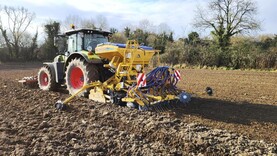Ground conditions: Land condition depends on where you are in the country yet again. This time the south escaped the worst of the rain, but conditions are wet in much of the northern half of the country.
While planting continues in places, most fieldwork has been stopped in other parts of the country. Growers are prepared to let these few days of broken weather pass in the hope of better weather to come. The break may provide opportunities to get pre-emerge herbicides applied.
Winter rape: Examine early sown crops for the presence of downy mildew, light leafspot (LLS) or phoma. Treatment of downy mildew is only likely to be warranted on younger crops. Treatment of phoma or LLS may be warranted if at least 25% of plants show 20% infection. This threshold should be higher when plants are bigger and vice versa.
Products like Fezan, Proline, Magnello or Prosaro are options. These also have growth regulator properties, which might be useful. The minimum rate for disease control is half-rate and higher rates give more growth regulation.
Clean crops at the four-to-six-leaf stage might be best treated with Juventus at 0.4-0.6l/ha for growth regulation. The recommendation is for 0.08l/ha per leaf based on the average. So, the rate for a 6-leaf crop is 0.08 x 6 = 0.48l/ha. Other fungicides can be added where growth regulation is the priority. Excess regulation can be negative for yield in crops that have small canopies.
There has been an amount of frost hardening of crops, but it may still be a bit too early to consider the propyzamide-based products (Kerb types).
Planting decisions: Planting seems likely to get back into full swing after the weekend. It is important to have seed on hand or to know where you can get it if a planting window opens. While some crops are already peeping, most winter crops are still to be sown. Some growers may have to move around to get fields that are fit for planting but keep your rotation intact.
Decision on crop priority should be based around rotation and profitability. Wheat is the preferable crop for some, for others it may be barley or oats. Get your most difficult fields planted as soon as possible to give them the best chance. Easier ground can be planted later into the season.
If establishment conditions are less than ideal, increase seed rate for winter wheat up to 280 seeds/m2 or 155kg/ha (10 st/ac) for 50g seed. For winter barley, push towards 380 seeds/m2 with up to 200 kg/ha (12 st/ac) for up to 50g seed. Oat planting will be getting under way now at 140-155 kg/ha (9-10 st/ac) for 350-380 seeds/m2 from 40g seed. Smaller seeds require less weight per hectare for any given seed population.
Roll post sowing where/if conditions are good enough. Consider rolling a second time in a different direction if you expect severe problems from pests like slugs.






 This is a subscriber-only article
This is a subscriber-only article









SHARING OPTIONS: